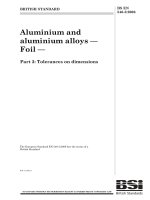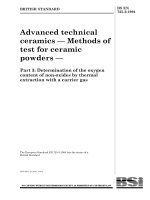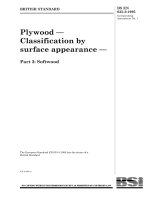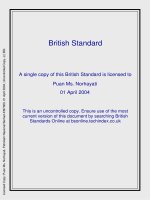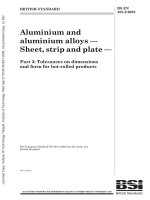Bsi bs en 61158 3 16 2008
Bạn đang xem bản rút gọn của tài liệu. Xem và tải ngay bản đầy đủ của tài liệu tại đây (332.98 KB, 30 trang )
BS EN 61158-3-16:2008
BSI British Standards
Industrial communication
networks — Fieldbus
specifications —
Part 3-16: Data-link layer service
definition — Type 16 elements
NO COPYING WITHOUT BSI PERMISSION EXCEPT AS PERMITTED BY COPYRIGHT LAW
raising standards worldwide™
BRITISH STANDARD
BS EN EN 61158-3-16:2008
National foreword
This British Standard is the UK implementation of EN 61158-3-16:2008. It is
identical to IEC 61158-3-16:2007. Together with all of the other sections of
BS EN 61158-3, it supersedes BS EN 61158-3:2004 which is withdrawn.
The UK participation in its preparation was entrusted to Technical Committee
AMT/7, Industrial communications: process measurement and control, including fieldbus.
A list of organizations represented on this committee can be obtained on
request to its secretary.
This publication does not purport to include all the necessary provisions of a
contract. Users are responsible for its correct application.
© BSI 2009
ISBN 978 0 580 61570 2
ICS 25.040.40; 35.100.20; 35.240.50
Compliance with a British Standard cannot confer immunity from
legal obligations.
This British Standard was published under the authority of the Standards
Policy and Strategy Committee on 31 January 2009.
Amendments issued since publication
Amd. No.
Date
Text affected
BS EN 61158-3-16:2008
EUROPEAN STANDARD
EN 61158-3-16
NORME EUROPÉENNE
February 2008
EUROPÄISCHE NORM
ICS 35.100.20; 25.040.40
Partially supersedes EN 61158-3:2004 and EN 61491:1998
English version
Industrial communication networks Fieldbus specifications Part 3-16: Data-link layer service definition Type 16 elements
(IEC 61158-3-16:2007)
Réseaux de communication industriels Spécifications des bus de terrain Partie 3-16: Définition des services
des couches de liaison de données Eléments de type 16
(CEI 61158-3-16:2007)
Industrielle Kommunikationsnetze Feldbusse Teil 3-16: Dienstfestlegungen des
Data Link Layer (Sicherungsschicht) Typ 16-Elemente
(IEC 61158-3-16:2007)
This European Standard was approved by CENELEC on 2008-02-01. CENELEC members are bound to comply
with the CEN/CENELEC Internal Regulations which stipulate the conditions for giving this European Standard
the status of a national standard without any alteration.
Up-to-date lists and bibliographical references concerning such national standards may be obtained on
application to the Central Secretariat or to any CENELEC member.
This European Standard exists in three official versions (English, French, German). A version in any other
language made by translation under the responsibility of a CENELEC member into its own language and notified
to the Central Secretariat has the same status as the official versions.
CENELEC members are the national electrotechnical committees of Austria, Belgium, Bulgaria, Cyprus, the
Czech Republic, Denmark, Estonia, Finland, France, Germany, Greece, Hungary, Iceland, Ireland, Italy, Latvia,
Lithuania, Luxembourg, Malta, the Netherlands, Norway, Poland, Portugal, Romania, Slovakia, Slovenia, Spain,
Sweden, Switzerland and the United Kingdom.
CENELEC
European Committee for Electrotechnical Standardization
Comité Européen de Normalisation Electrotechnique
Europäisches Komitee für Elektrotechnische Normung
Central Secretariat: rue de Stassart 35, B - 1050 Brussels
© 2008 CENELEC -
All rights of exploitation in any form and by any means reserved worldwide for CENELEC members.
Ref. No. EN 61158-3-16:2008 E
BS EN 61158-3-16:2008
EN 61158-3-16:2008
-2-
Foreword
The text of document 65C/473/FDIS, future edition 1 of IEC 61158-3-16, prepared by SC 65C, Industrial
networks, of IEC TC 65, Industrial-process measurement, control and automation, was submitted to the
IEC-CENELEC parallel vote and was approved by CENELEC as EN 61158-3-16 on 2008-02-01.
This and the other parts of the EN 61158-3 series supersede EN 61158-3:2004. Together with
EN 61158-2:2008 and its companion parts for Type 16, it also partially replaces EN 61491:1998 which is
at present being revised (to be issued as a Technical Report).
With respect to EN 61158-3:2004 the following changes were made:
– deletion of Type 6 fieldbus, and the placeholder for a Type 5 fieldbus data-link layer, for lack of market
relevance;
– addition of new fieldbus types;
– partition into multiple parts numbered 3-1, 3-2, …, 3-19.
The following dates were fixed:
– latest date by which the EN has to be implemented
at national level by publication of an identical
national standard or by endorsement
(dop)
2008-11-01
– latest date by which the national standards conflicting
with the EN have to be withdrawn
(dow)
2011-02-01
NOTE Use of some of the associated protocol types is restricted by their intellectual-property-right holders. In all cases, the
commitment to limited release of intellectual-property-rights made by the holders of those rights permits a particular data-link layer
protocol type to be used with physical layer and application layer protocols in type combinations as specified explicitly in the
EN 61784 series. Use of the various protocol types in other combinations may require permission from their respective
intellectual-property-right holders.
Annex ZA has been added by CENELEC.
__________
Endorsement notice
The text of the International Standard IEC 61158-3-16:2007 was approved by CENELEC as a European
Standard without any modification.
In the official version, for Bibliography, the following notes have to be added for the standards indicated:
IEC 61158-2
NOTE Harmonized as EN 61158-2:2008 (not modified).
IEC 61158-4-16
NOTE Harmonized as EN 61158-4-16:2008 (not modified).
IEC 61158-5-16
NOTE Harmonized as EN 61158-5-16:2008 (not modified).
IEC 61158-6-16
NOTE Harmonized as EN 61158-6-16:2008 (not modified).
IEC 61784-1
NOTE Harmonized as EN 61784-1:2008 (not modified).
__________
BS EN 61158-3-16:2008
-3-
EN 61158-3-16:2008
Annex ZA
(normative)
Normative references to international publications
with their corresponding European publications
The following referenced documents are indispensable for the application of this document. For dated
references, only the edition cited applies. For undated references, the latest edition of the referenced
document (including any amendments) applies.
NOTE When an international publication has been modified by common modifications, indicated by (mod), the relevant EN/HD
applies.
Publication
Year
ISO/IEC 7498-1
-
ISO/IEC 7498-3
ISO/IEC 10731
1)
2)
Title
EN/HD
1)
Information technology - Open Systems
Interconnection - Basic Reference Model:
The Basic Model
EN ISO/IEC 7498-1 1995
-
1)
Information technology - Open Systems
Interconnection - Basic Reference Model:
Naming and addressing
-
-
-
1)
Information technology - Open Systems
Interconnection - Basic reference model Conventions for the definition of OSI services
-
Undated reference.
Valid edition at date of issue.
Year
2)
BS EN 61158-3-16:2008
–2–
61158-3-16 © IEC:2007(E)
CONTENTS
0
I NTRODUCTION..................................................................................................................... 5
1H
2H
1
Scope ............................................................................................................................... 6
2H
23H
2
1 .1 Overview ................................................................................................................. 6
1 .2 Specifications .......................................................................................................... 6
1 .3 Conformance........................................................................................................... 6
Normative references ....................................................................................................... 7
3
Terms, definitions, symbols, abbreviations and conventions ............................................. 7
24H
4H
25H
5H
26H
6H
3H
7H
27H
28H
3 .1 Reference model terms and definitions .................................................................... 7
3 .2 Service convention terms and definitions................................................................. 8
3 .3 Data-link service terms and definitions .................................................................... 9
3 .4 Symbols and abbreviations.................................................................................... 1 2
3 .5 Common conventions ............................................................................................ 1 3
Data-link services and concepts ..................................................................................... 1 4
8H
29H
9H
30H
10H
31H
32H
12H
3H
4
1H
13H
34H
4 .1 Overview ............................................................................................................... 1 4
4 .2 Service channel services (SVC services)............................................................... 1 6
4 .3 Realtime channel setup services (RTCS services) ................................................. 1 8
4 .4 RTC services......................................................................................................... 2 0
4 .5 File transmission services ..................................................................................... 2 3
B ibliography.......................................................................................................................... 2 5
14H
35H
15H
36H
16H
37H
17H
38H
18H
39H
19H
40H
Figure 1 – Relationships of DLSAPs, DLSAP-addresses and group DL-addresses ................ 1 0
41H
Table 1 – Summary of DL services and primitives ................................................................. 1 6
42H
Table 2 – Read (RD) ............................................................................................................. 1 7
43H
Table 3 – Write (WR) ............................................................................................................ 1 8
4H
Table 4 – Initiate_cyclic_communication (ICC) ...................................................................... 1 9
45H
Table 5 – Disable_cyclic_communication (DCC) ................................................................... 2 0
46H
Table 6 – Notify_Error (NER) ................................................................................................ 2 0
47H
Table 7 – Write_cyclic (WRC) ............................................................................................... 2 1
48H
Table 8 – Get_Device_Status (GDS) ..................................................................................... 2 1
49H
Table 9 – Write_Device_Status (SDS)................................................................................... 2 2
50H
Table 10 – Notify_Network_Status_Change (NNSC) ............................................................. 2 3
51H
Table 11 – File download (FD) .............................................................................................. 2 3
52H
Table 12 – File upload (FU) .................................................................................................. 2 4
53H
BS EN 61158-3-16:2008
61158-3-16 © IEC:2007(E)
–5–
INTRODUCTION
This part of IEC 61158 is one of a series produced to facilitate the interconnection of
automation system components. It is related to other standards in the set as defined by the
“three-layer” fieldbus reference model described in IEC/TR 61158-1.
Throughout the set of fieldbus standards, the term “service” refers to the abstract capability
provided by one layer of the OSI Basic Reference Model to the layer immediately above.
Thus, the data-link layer service defined in this standard is a conceptual architectural service,
independent of administrative and implementation divisions.
BS EN 61158-3-16:2008
–6–
61158-3-16 © IEC:2007(E)
INDUSTRIAL COMMUNICATION NETWORKS –
FIELDBUS SPECIFICATIONS –
Part 3-16: Data-link layer service definition – Type 16 elements
1 Scope
1.1 Overview
This standard provides common elements for basic time-critical messaging communications
between devices in an automation environment. The term “time-critical” is used to represent
the presence of a time-window, within which one or more specified actions are required to be
completed with some defined level of certainty. Failure to complete specified actions within
the time window risks failure of the applications requesting the actions, with attendant risk to
equipment, plant and possibly human life.
This standard defines in an abstract way the externally visible service provided by the Type
16 fieldbus data-link layer in terms of
a) the primitive actions and events of the service;
b) the parameters associated with each primitive action and event, and the form which they
take; and
c) the interrelationship between these actions and events, and their valid sequences.
The purpose of this standard is to define the services provided to
•
the Type 16 fieldbus application layer at the boundary between the application and datalink layers of the fieldbus reference model, and
•
systems management at the boundary between the data-link layer and systems
management of the fieldbus reference model.
1.2 Specifications
The principal objective of this standard is to specify the characteristics of conceptual data-link
layer services suitable for time-critical communications, and thus supplement the OSI Basic
Reference Model in guiding the development of data-link protocols for time-critical
communications. A secondary objective is to provide migration paths from previously-existing
industrial communications protocols.
This specification may be used as the basis for formal DL-Programming-Interfaces.
Nevertheless, it is not a formal programming interface, and any such interface will need to
address implementation issues not covered by this specification, including
a) the sizes and octet ordering of various multi-octet service parameters, and
b) the correlation of paired request and confirm, or indication and response, primitives.
1.3 Conformance
This standard does not specify individual implementations or products, nor do they constrain
the implementations of data-link entities within industrial automation systems.
There is no conformance of equipment to this data-link layer service definition standard.
Instead, conformance is achieved through implementation of the corresponding data-link
protocol that fulfills the Type 16 data-link layer services defined in this standard.
BS EN 61158-3-16:2008
61158-3-16 © IEC:2007(E)
–7–
2 Normative references
The following referenced documents are indispensable for the application of this document.
For dated references, only the edition cited applies. For undated references, the latest edition
of the referenced document (including any amendments) applies.
ISO/IEC 7498-1, Information technology – Open Systems Interconnection – Basic Reference
Model: The Basic Model
ISO/IEC 7498-3, Information technology – Open Systems Interconnection – Basic Reference
Model: Naming and addressing
ISO/IEC 10731, Information technology – Open Systems Interconnection – Basic Reference
Model – Conventions for the definition of OSI services
3 Terms, definitions, symbols, abbreviations and conventions
For the purposes of this document, the following terms, definitions, symbols, abbreviations
and conventions apply.
3.1 Reference model terms and definitions
This standard is based in part on the concepts developed in ISO/IEC 7498-1 and ISO/IEC
7498-3, and makes use of the following terms defined therein:
3.1.1 DL-address
[7498-3]
3.1.2 DL-address-mapping
[7498-1]
3.1.3 called-DL-address
[7498-3]
3.1.4 calling-DL-address
[7498-3]
3.1.5 centralized multi-end-point-connection
[7498-1]
3.1.6 DL-connection
[7498-1]
3.1.7 DL-connection-end-point
[7498-1]
3.1.8 DL-connection-end-point-identifier
[7498-1]
3.1.9 DL-connection-mode transmission
[7498-1]
3.1.10 DL-connectionless-mode transmission
[7498-1]
3.1.11 correspondent (N)-entities
correspondent DL-entities (N=2)
correspondent Ph-entities (N=1)
[7498-1]
3.1.12 DL-duplex-transmission
[7498-1]
3.1.13 (N)-entity
DL-entity (N=2)
Ph-entity (N=1)
[7498-1]
3.1.14 DL-facility
[7498-1]
3.1.15 flow control
[7498-1]
BS EN 61158-3-16:2008
–8–
61158-3-16 © IEC:2007(E)
3.1.16 (N)-layer
DL-layer (N=2)
Ph-layer (N=1)
[7498-1]
3.1.17 layer-management
[7498-1]
3.1.18 DL-local-view
[7498-3]
3.1.19 DL-name
[7498-3]
3.1.20 naming-(addressing)-domain
[7498-3]
3.1.21 peer-entities
[7498-1]
3.1.22 primitive name
[7498-3]
3.1.23 DL-protocol
[7498-1]
3.1.24 DL-protocol-connection-identifier
[7498-1]
3.1.25 DL-protocol-data-unit
[7498-1]
3.1.26 DL-relay
[7498-1]
3.1.27 reset
[7498-1]
3.1.28 responding-DL-address
[7498-3]
3.1.29 routing
[7498-1]
3.1.30 segmenting
[7498-1]
3.1.31 (N)-service
DL-service (N=2)
Ph-service (N=1)
[7498-1]
3.1.32 (N)-service-access-point
DL-service-access-point (N=2)
Ph-service-access-point (N=1)
[7498-1]
3.1.33 DL-service-access-point-address
[7498-3]
3.1.34 DL-service-connection-identifier
[7498-1]
3.1.35 DL-service-data-unit
[7498-1]
3.1.36 DL-simplex-transmission
[7498-1]
3.1.37 DL-subsystem
[7498-1]
3.1.38 systems-management
[7498-1]
3.1.39 DL-user-data
[7498-1]
3.2 Service convention terms and definitions
This standard also makes use of the following terms defined in ISO/IEC 10731 as they apply
to the data-link layer:
3.2.1 acceptor
3.2.2 asymmetrical service
BS EN 61158-3-16:2008
61158-3-16 © IEC:2007(E)
–9–
3.2.3 confirm (primitive);
requestor.deliver (primitive)
3.2.4 deliver (primitive)
3.2.5 DL-confirmed-facility
3.2.6 DL-facility
3.2.7 DL-local-view
3.2.8 DL-mandatory-facility
3.2.9 DL-non-confirmed-facility
3.2.10 DL-provider-initiated-facility
3.2.11 DL-provider-optional-facility
3.2.12 DL-service-primitive;
primitive
3.2.13 DL-service-provider
3.2.14 DL-service-user
3.2.15 DL-user-optional-facility
3.2.16 indication (primitive);
acceptor.deliver (primitive)
3.2.17 multi-peer
3.2.18 request (primitive);
requestor.submit (primitive)
3.2.19 requestor
3.2.20 response (primitive);
acceptor.submit (primitive)
3.2.21 submit (primitive)
3.2.22 symmetrical service
3.3 Data-link service terms and definitions
3.3.1
cycle time
duration of a communication cycle
3.3.2
cyclic communication
periodic exchange of telegrams
3.3.3
cyclic data
part of a telegram, which does not change its meaning during cyclic operation of the network
3.3.4
cyclic operation
operation in which devices in the communication network are addressed and queried one after
the other at fixed, constant time intervals
BS EN 61158-3-16:2008
– 10 –
61158-3-16 © IEC:2007(E)
3.3.5
device
a slave in the communication network, (e.g., a power drive system as defined in the IEC
61800 standard family, I/O stations as defined in the IEC 61131 standard family)
3.3.6
device status
four adjacent octets inside the acknowledge telegram containing status information for each
device
3.3.7
DL-segment, link, local link
single DL-subnetwork in which any of the connected DLEs may communicate directly, without
any intervening DL-relaying, whenever all of those DLEs that are participating in an instance
of communication are simultaneously attentive to the DL-subnetwork during the period(s) of
attempted communication
DLS-user-entity
DLS-user-entity
DLS-users
DLSAP
DLSAP
DLSAPaddress
DLSAPaddresses
DL-layer
DLSAP
group DLaddress
DLSAPaddress
DL-entity
PhSA P
PhSA P
Ph-layer
NOTE 1
DLSAPs and PhSAPs are depicted as ovals spanning the boundary between two adjacent layers.
NOTE 2
DL-addresses are depicted as designating small gaps (points of access) in the DLL portion of a DLSAP.
NOTE 3 A single DL-entity may have multiple DLSAP-addresses and group DL-addresses associated with a
single DLSAP.
Figure 1 – Relationships of DLSAPs, DLSAP-addresses and group DL-addresses
3.3.8
DLSAP
distinctive point at which DL-services are provided by a single DL-entity to a single higherlayer entity
NOTE This definition, derived from ISO/IEC 7498-1, is repeated here to facilitate understanding of the critical
distinction between DLSAPs and their DL-addresses.
BS EN 61158-3-16:2008
61158-3-16 © IEC:2007(E)
– 11 –
3.3.9
DL(SAP)-address
either an individual DLSAP-address, designating a single DLSAP of a single DLS-user, or a
group DL-address potentially designating multiple DLSAPs, each of a single DLS-user
NOTE This terminology is chosen because ISO/IEC 7498-3 does not permit the use of the term DLSAP-address to
designate more than a single DLSAP at a single DLS-user.
3.3.10
(individual) DLSAP-address
DL-address that designates only one DLSAP within the extended link
NOTE
A single DL-entity may have multiple DLSAP-addresses associated with a single DLSAP.
3.3.11
element
part of IDNs – each IDN has 7 elements, whereas each one has a specific meaning (e.g.,
number, name, data)
3.3.12
extended link
DL-subnetwork, consisting of the maximal set of links interconnected by DL-relays, sharing a
single DL-name (DL-address) space, in which any of the connected DL-entities may
communicate, one with another, either directly or with the assistance of one or more of those
intervening DL-relay entities
NOTE
An extended link may be composed of just a single link.
3.3.13
frame
denigrated synonym for DLPDU
3.3.14
group DL-address
DL-address that potentially designates more than one DLSAP within the extended link. A
single DL-entity may have multiple group DL-addresses associated with a single DLSAP. A
single DL-entity also may have a single group DL-address associated with more than one
DLSAP
3.3.15
hot plug
possibility to open the communication network and insert or remove slaves while the network
is still in real-time operation
3.3.16
identification number (IDN)
designation of operating data under which a data block is preserved with its attribute, name,
unit, minimum and maximum input values, and the data
3.3.17
node
single DL-entity as it appears on one local link
3.3.18
protocol
convention about the data formats, time sequences, and error correction in the data exchange
of communication systems
3.3.19
receiving DLS-user
DL-service user that acts as a recipient of DL-user-data
BS EN 61158-3-16:2008
– 12 –
NOTE
61158-3-16 © IEC:2007(E)
A DL-service user can be concurrently both a sending and receiving DLS-user.
3.3.20
sending DLS-user
DL-service user that acts as a source of DL-user-data
3.3.21
service channel (SVC)
non real-time transmission of information upon master request during RT channel
3.3.22
slave
node, which is assigned the right to transmit by the master
3.3.23
station
node
3.3.24
telegram
frame
3.3.25
topology
physical network architecture with respect to the connection between the stations of the
communication system
3.4 Symbols and abbreviations
3.4.1 DL-
Data-link layer (as a prefix)
3.4.2 DLC
DL-connection
3.4.3 DLCEP
DL-connection-end-point
3.4.4 DLE
DL-entity (the local active instance of the data-link layer)
3.4.5 DLL
DL-layer
3.4.6 DLPCI
DL-protocol-control-information
3.4.7 DLPDU
DL-protocol-data-unit
3.4.8 DLM
DL-management
3.4.9 DLME
DL-management Entity (the local active instance of
DL-management)
3.4.10 DLMS
DL-management Service
3.4.11 DLS
DL-service
3.4.12 DLSAP
DL-service-access-point
3.4.13 DLSDU
DL-service-data-unit
3.4.14 FIFO
First-in first-out (queuing method)
3.4.15 IDN
Identification Number
3.4.16 OSI
Open systems interconnection
BS EN 61158-3-16:2008
61158-3-16 © IEC:2007(E)
– 13 –
3.4.17 Ph-
Physical layer (as a prefix)
3.4.18 PhE
Ph-entity (the local active instance of the physical layer)
3.4.19 PhL
Ph-layer
3.4.20 QoS
Quality of service
3.4.21 RE
Resource element
3.4.22 RTC
Real-time channel
3.4.23 SI
Sub Index
3.4.24 SVC
Service channel
3.5 Common conventions
This standard uses the descriptive conventions given in ISO/IEC 10731.
The service model, service primitives, and time-sequence diagrams used are entirely abstract
descriptions; they do not represent a specification for implementation.
Service primitives, used to represent service user/service provider interactions (see ISO/IEC
10731), convey parameters that indicate information available in the user/provider interaction.
This standard uses a tabular format to describe the component parameters of the DLS
primitives. The parameters that apply to each group of DLS primitives are set out in tables
throughout the remainder of this standard. Each table consists of up to six columns,
containing the name of the service parameter, and a column each for those primitives and
parameter-transfer directions used by the DLS:
⎯ the request primitive’s input parameters;
⎯ the request primitive’s output parameters;
⎯ the indication primitive’s output parameters;
⎯ the response primitive’s input parameters; and
⎯ the confirm primitive’s output parameters.
NOTE The request, indication, response and confirm primitives are also known as requestor.submit,
acceptor.deliver, acceptor.submit, and requestor.deliver primitives, respectively (see ISO/IEC 10731).
One parameter (or part of it) is listed in each row of each table. Under the appropriate service
primitive columns, a code is used to specify the type of usage of the parameter on the
primitive and parameter direction specified in the column:
M
— parameter is mandatory for the primitive.
U
— parameter is a User option, and may or may not be provided depending on
the dynamic usage of the DLS-user. When not provided, a default value for
the parameter is assumed.
C
— parameter is conditional upon other parameters or upon the environment of
the DLS-user.
(blank)
— parameter is never present.
Some entries are further qualified by items in brackets. These may be
BS EN 61158-3-16:2008
– 14 –
61158-3-16 © IEC:2007(E)
a) a parameter-specific constraint
(=) indicates that the parameter is semantically equivalent to the parameter in the
service primitive to its immediate left in the table;
b) an indication that some note applies to the entry
(n) indicates that the following note n contains additional information pertaining to the
parameter and its use.
In any particular interface, not all parameters need be explicitly stated. Some may be
implicitly associated with the DLSAP at which the primitive is issued.
In the diagrams which illustrate these interfaces, dashed lines indicate cause-and-effect or
time-sequence relationships, and wavy lines indicate that events are roughly
contemporaneous.
4
Data-link services and concepts
4.1 Overview
The data-link layer specifies services for reading and writing data from devices in a Type 16
network. The mechanisms for using these services are related to the Type 16 specific
Identification Numbers (IDN). There are three different types of services:
•
Service channel services (confirmed, non-cyclic)
•
File transfer services (confirmed, non-cyclic)
•
Real-time channel setup services (confirmed, non-cyclic)
•
Real-time channel services (confirmed, cyclic).
Table 1 gives a Summary of DL services and primitives.
4.1.1 Acknowledged connection oriented data transfer: Read (RD)
This service permits the local DLS-user to send a DLSDU to a single remote station. At the
remote station the DLSDU, if the respective DLPDU is transferred error-free, is delivered by
the remote DLE to its local DLS-user and answered by it. This response is send back. The
originating local DLS-user receives a confirmation answer of the DLSDU by the remote DLSuser. If an error occurred during the transfer, the originating DLE repeats the data transfer up
to a configured maximum number of times.
4.1.2 Acknowledged connection oriented data transfer: Read (WR)
This service permits the local DLS-user to send a DLSDU to a single remote station. At the
remote station the DLSDU, if the respective DLPDU is transferred error-free, is delivered by
the remote DLE to its local DLS-user and answered by it. This response is send back. The
originating local DLS-user receives a confirmation answer of the DLSDU by the remote DLSuser. If an error occurred during the transfer, the originating DLE repeats the data transfer up
to a configured maximum number of times.
4.1.3
Acknowledged connection oriented data transfer: Initiate_cyclic_communication
(ICC)
This service permits the local DLS-user to send a DLSDU to a several remote station. At the
remote station the DLSDU, if the respective DLPDU is transferred error-free, is delivered by
the remote DLE to its local DLS-user and answered by it. This response is send back. The
originating local DLS-user receives a confirmation answer of the DLSDU by the remote DLSuser. If an error occurred during the transfer, the originating DLE repeats the data transfer up
to a configured maximum number of times.
BS EN 61158-3-16:2008
61158-3-16 © IEC:2007(E)
4.1.4
– 15 –
Acknowledged connection oriented data transfer: Disable_cyclic_communication
(DCC)
This service permits the local DLS-user to send a DLSDU to remote stations. At the remote
station the DLSDU, if the respective DLPDU is transferred error-free, is delivered by the
remote DLE to its local DLS-user and answered by it. This response is send back. The
originating local DLS-user receives a confirmation answer of the DLSDU by the remote DLSuser. If an error occurred during the transfer, the originating DLE repeats the data transfer up
to a configured maximum number of times.
4.1.5 Unacknowledged connectionless data transfer: Write_cyclic (WRC)
This service permits a local DLS-user to transfer a DLSDU to a single remote station or a list
of stations. The local DLS-user receives a confirmation acknowledging the completion of the
transfer, but not whether the DLPDU was duly received. At each addressed remote station
this DLSDU, if the respective DLPDU is received error-free, is delivered to a single local DLSuser. There is no confirmation to the sending DLS-user that such an intended delivery has
taken place.
4.1.6 Unacknowledged connectionless data transfer: Send_Device_Status (SDS)
This service permits a local DLS-user to transfer a DLSDU to a single remote station . The
local DLS-user receives a confirmation acknowledging the completion of the transfer, but not
whether the DLPDU was duly received. At the addressed remote station this DLSDU, if the
respective DLPDU is received error-free, is delivered to a single local DLS-user. There is no
confirmation to the sending DLS-user that such an intended delivery has taken place.
4.1.7 Unacknowledged connectionless data transfer: Write_Device_Status (WDS)
This service permits a local DLS-user to transfer a DLSDU to a single remote station . The
local DLS-user receives a confirmation acknowledging the completion of the transfer, but not
whether the DLPDU was duly received. At the addressed remote station this DLSDU, if the
respective DLPDU is received error-free, is delivered to a single local DLS-user. There is no
confirmation to the sending DLS-user that such an intended delivery has taken place.
4.1.8 Acknowledged connection oriented data transfer: File download (FD)
This service permits the local DLS-user to send a DLSDU to remote stations. At the remote
station the DLSDU, if the respective DLPDU is transferred error-free, is delivered by the
remote DLE to its local DLS-user and answered by it. This response is send back. The
originating local DLS-user receives a confirmation answer of the DLSDU by the remote DLSuser. If an error occurred during the transfer, the originating DLE repeats the data transfer up
to a configured maximum number of times.
4.1.9 Acknowledged connection oriented data transfer: File download (FD)
This service permits the local DLS-user to send a DLSDU to remote stations. At the remote
station the DLSDU, if the respective DLPDU is transferred error-free, is delivered by the
remote DLE to its local DLS-user and answered by it. This response is send back. The
originating local DLS-user receives a confirmation answer of the DLSDU by the remote DLSuser. If an error occurred during the transfer, the originating DLE repeats the data transfer up
to a configured maximum number of times.
BS EN 61158-3-16:2008
– 16 –
61158-3-16 © IEC:2007(E)
Table 1 – Summary of DL services and primitives
Service
Primitive
Acknowledged connection oriented data transfer:
DL-RD request
Read (RD)
DL-RD confirm
DL-RD indication
Possible for these station classes
Master
Slave
DL-RD response
Acknowledged connection oriented data transfer:
DL-WR request
Write (WR)
DL-WR confirm
DL-WR indication
Master
Slave
DL-WR response
Acknowledged connection oriented data transfer: DL-ICC request
Initiate_cyclic_communication (ICC)
Master
DL-ICC confirm
DL-ICC indication
Slave
DL-ICC response
Acknowledged connection oriented data transfer: DL-DCC request
Disable_cyclic_communication (DCC)
Master
DL-DCC confirm
DL-DCC indication Slave
DL-DCC response
Unacknowledged connectionless data transfer:
Write_cyclic (WRC)
DL-WRC request
Master or Slave
DL-WRC confirm
DL-WRC indication Slave or Master
Unacknowledged connectionless data transfer:
DL-SDS request
Send_Device_Status (SDS)
DL-SDS confirm
Slave
DL-SDS indication
Master
Unacknowledged connectionless data transfer:
DL-WDS request
Master
Write_Device_Status (WDS)
DL-WDS confirm
DL-WDS indication Slave
Acknowledged connection oriented data transfer:
File download (FD)
DL-FD request
Master
DL-FD confirm
DL-FD indication
Slave
DL-FD response
Acknowledged connection oriented data transfer:
DL-FU request
File upload (FU)
DL-FU confirm
DL-FU indication
Master
Slave
DL-FU response
4.2
Service channel services (SVC services)
With the services of the service channel, a master reads or writes elements of an IDN of a
slave device.
4.2.1
Read (RD)
4.2.1.1 Function
With the RD service, a master reads elements of an IDN from one device selected by a device
address (see T able 2).
54H
BS EN 61158-3-16:2008
61158-3-16 © IEC:2007(E)
– 17 –
Table 2 – Read (RD)
Request
Indication
Response
Confirmation
input
output
input
output
Device address
M
M (=)
IDN
M
M (=)
Element
M
M (=)
Data
M
M (=)
Error code
M
M (=)
Parameter name
NOTE The method by which a confirm primitive is correlated with its corresponding preceding
request primitive is a local matter. The method by which a response primitive is correlated
with its corresponding preceding indication primitive is a local matter. See 1.2.
4.2.1.2 Request and Indication parameters
4.2.1.2.1 Device address
This parameter is used to address the device from which the data is to be read.
4.2.1.2.2 IDN
This parameter is used to identify the IDN from which the data is to beread.
4.2.1.2.3 Element
This parameter is used to identify the element of the IDN that is to be read.
4.2.1.3 Response and confirmation parameters
The result is used to convey the service specific parameters of the service response.
4.2.1.3.1 Data
This parameter specifies the data which was read from the device.
4.2.1.3.2 Error code
This parameter specifies the error code of the read request.
4.2.2
Write (WR)
4.2.2.1 Function
With the Write services a master writes elements of an IDN to one device selected by a
device address (see T able 3).
5H
BS EN 61158-3-16:2008
– 18 –
61158-3-16 © IEC:2007(E)
Table 3 – Write (WR)
Request
Indication
Response
Confirmation
input
output
input
output
Device address
M
M (=)
IDN
M
M (=)
Element
M
M (=)
Data
M
M (=)
M
M (=)
Parameter name
Error code
NOTE The method by which a confirm primitive is correlated with its corresponding preceding
request primitive is a local matter. The method by which a response primitive is correlated
with its corresponding preceding indication primitive is a local matter. See 1.2.
4.2.2.2 Request and Indication parameters
4.2.2.2.1 Device address
This parameter is used to address the device to which the data is to be written.
4.2.2.2.2 IDN
This parameter is used to identify the IDN from which the data is to be written.
4.2.2.2.3 Element
This parameter is used to identify the element of the IDN that is to be written.
4.2.2.2.4 Data
This parameter specifies the data which is written to the device.
4.2.2.3 Response and confirmation parameters
The result conveys the service specific parameters of the service response.
4.2.2.3.1 Error code
This parameter specifies the error code of the write request.
4.3
Realtime channel setup services (RTCS services)
With the Realtime channel setup services, a master establishes the cyclic communication.
4.3.1
Initiate_cyclic_communication (ICC)
4.3.1.1 Function
With the ICC service, a master initiates the cyclic communication with the slave devices in a
Type 16 network (see T able 4).
56H


